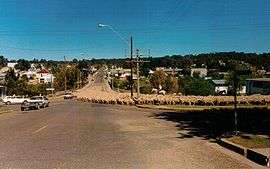Warialda
| Warialda New South Wales | |||||||
|---|---|---|---|---|---|---|---|
 Drovers taking sheep through Warialda | |||||||
 Warialda | |||||||
| Coordinates | 29°32′0″S 150°34′0″E / 29.53333°S 150.56667°ECoordinates: 29°32′0″S 150°34′0″E / 29.53333°S 150.56667°E | ||||||
| Population | 1,120 (2011 census)[1] | ||||||
| Postcode(s) | 2402 | ||||||
| Elevation | 320 m (1,050 ft) | ||||||
| Location | |||||||
| LGA(s) | Gwydir Shire | ||||||
| State electorate(s) | Northern Tablelands | ||||||
| Federal Division(s) | Parkes | ||||||
| |||||||
Warialda is a town in the Northwest Slopes region of New South Wales, Australia, in Gwydir Shire. Situated on the banks of Warialda Creek, the town's name means "Place of Wild Honey." At the 2011 census, Warialda had a population of 1,120.[1]
Transport
The Gwydir Highway runs through town and, along with Stephen Street, is considered one of the town's two main streets.
Warialda is serviced by daily NSW TrainLink coach services (excluding Tuesdays) to Inverell and Tamworth, connecting with train services to Sydney. Additionally, there are three weekly coach services each to Grafton (connecting with XPT train services to and from Brisbane) and Moree on alternating days (excluding Sundays). The NSW TrainLink coach stop is located outside the tourist information centre.[2]
History
Warialda was the first town gazetted in the Northwest Slopes region, probably in the 1830s, and was the headquarters of the Yallaroi Shire, until its merger with neighbouring Bingara Shire to form Gwydir Shire. Warialda Post Office opened on 1 January 1848.[3] The town's first newspaper was the Warialda Standard, which was first published in 1896 and remains in publication.[4][5]
Warialda is the birthplace of Elizabeth Kenny, world-renowned pioneer in the treatment of poliomyelitis.[6] The baptismal font used for Sister Kenny's baptism is still in use and housed in the Church of England located in Stewart Avenue.
Warialda is also the birthplace of Olive Rose Fitzhardinge (1881–1956) who became famous in the 1930s as a rose breeder in Warrawee, the name of her best known rose.[7]
Industry
Warialda is the service centre for the local agricultural sector. Farms around Warialda produce wheat, sorghum, barley, sheep, beef cattle. Some of the locals also earn a dollar or two hunting wild pigs, which are exported, mainly to Germany, where there are demands for wild boar which are not present in the Australian market.
Warialda serves as an education precinct for local families with a strong base of excellent education facilities including preschools, public schools, catholic schools, TAFE outreach centres and vocational education programs.
Agriculture, health and education are the primary industries providing support for a small but thriving business sector. Some of the local businesses include a supermarket, hardware store, cafes, service stations, butcher, bakery, pubs and a golf & bowling club along with other small businesses providing a cross-section of goods & services.
Religion

Warialda is home to congregations of the Anglican, Catholic, Presbyterian, and Uniting Churches.
The Anglican and Catholic churches are located near the Gwydir Highway in the main part of town on the south bank of the Warialda Creek.
Anglican Church
St. Simon's & St. Jude's Anglican Church is located on the corner of Stewart Avenue and Market Streets.
Presbyterian church
St. Stephen's Presbyterian Church is located on the corner of Stephen and Long Streets. The front of the church has three stained glass windows representing The Good Shepherd, from John 10:1-21, as an Australian scene.
The Presbyterian Manse was built from convict-hewn sandstone which formed part of the original town gaol. A local landowner used this stone built a house for himself and donated the rest of the stone to the church. The Manse bears examples of gaol graffiti, such as "Hell is here" upside-down outside the office window, and "Lord, remember me" at the back of the building.
Education
Warialda Public School is one of the oldest public schools in New South Wales. It was established in 1851.
Warialda High School has been named as a Centre for Excellence.
St Joseph's Catholic School provides education for K to 6.
Places of interest
Between Warialda and Inverell on the Gwydir Highway is Cranky Rock. According to local legend, in the 1800s a Chinese man jumped off Cranky Rock into the creek while being pursued by the local police. Cranky Rock is now a popular picnic spot.
Festivals
2008 marked the town's first Honey Festival. There is entertainment throughout the day, featuring local artists. In addition there are market stalls and refreshments available. The highlight of the day happens at 2pm when there is a street parade with colourful floats constructed and manned by community groups. On 21 November 2009, the second annual Honey Festival was held and after two successful Honey Festivals this local day of festivities looks like being annual event on the Warialda calendar.
References
- 1 2 Australian Bureau of Statistics (31 October 2012). "Warialda (L) (Urban Centre/Locality)". 2011 Census QuickStats. Retrieved 9 November 2012.
- ↑ "CountryLink Timetables". Retrieved 1 August 2012.
- ↑ Premier Postal History. "Post Office List". Premier Postal Auctions. Retrieved 26 May 2011.
- ↑ Kirkpatrick, Rod (2000). Country Conscience: a history of the New South Wales provincial press 1841-1995. Canberra: Infinite Harvest Publishing Pty Ltd.
- ↑ "About the Warialda Standard". Warialda Standard. Retrieved 11 March 2015.
- ↑ Ross Patrick. "Kenny, Elizabeth (1880–1952)". Australian Dictionary of Biography. Retrieved 5 August 2012.
- ↑ "NEW AUSTRALIAN ROSE.". The Sydney Morning Herald. National Library of Australia. 30 January 1931. p. 9. Retrieved 23 July 2014.
External links
![]() Media related to Warialda, New South Wales at Wikimedia Commons
Media related to Warialda, New South Wales at Wikimedia Commons